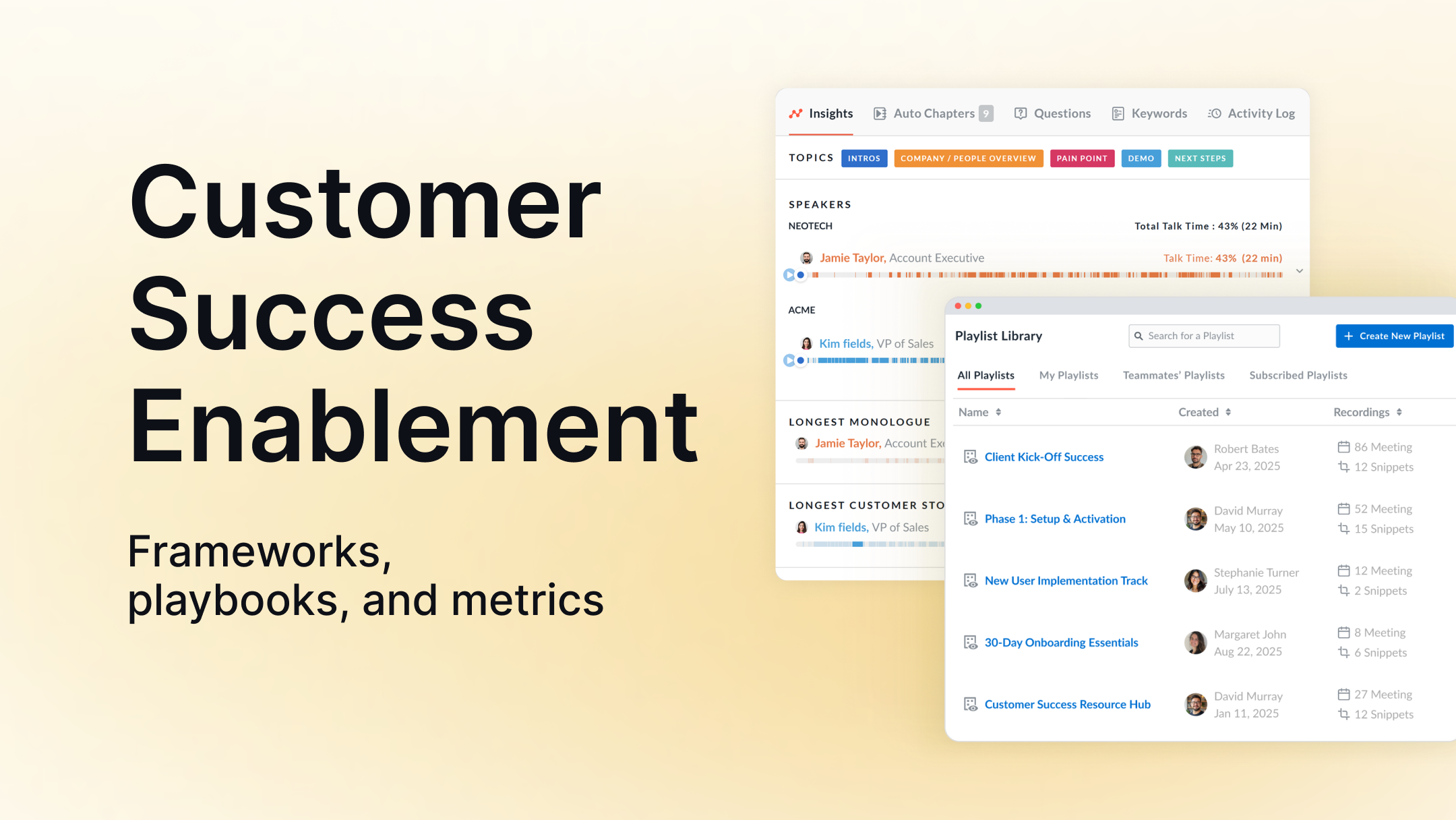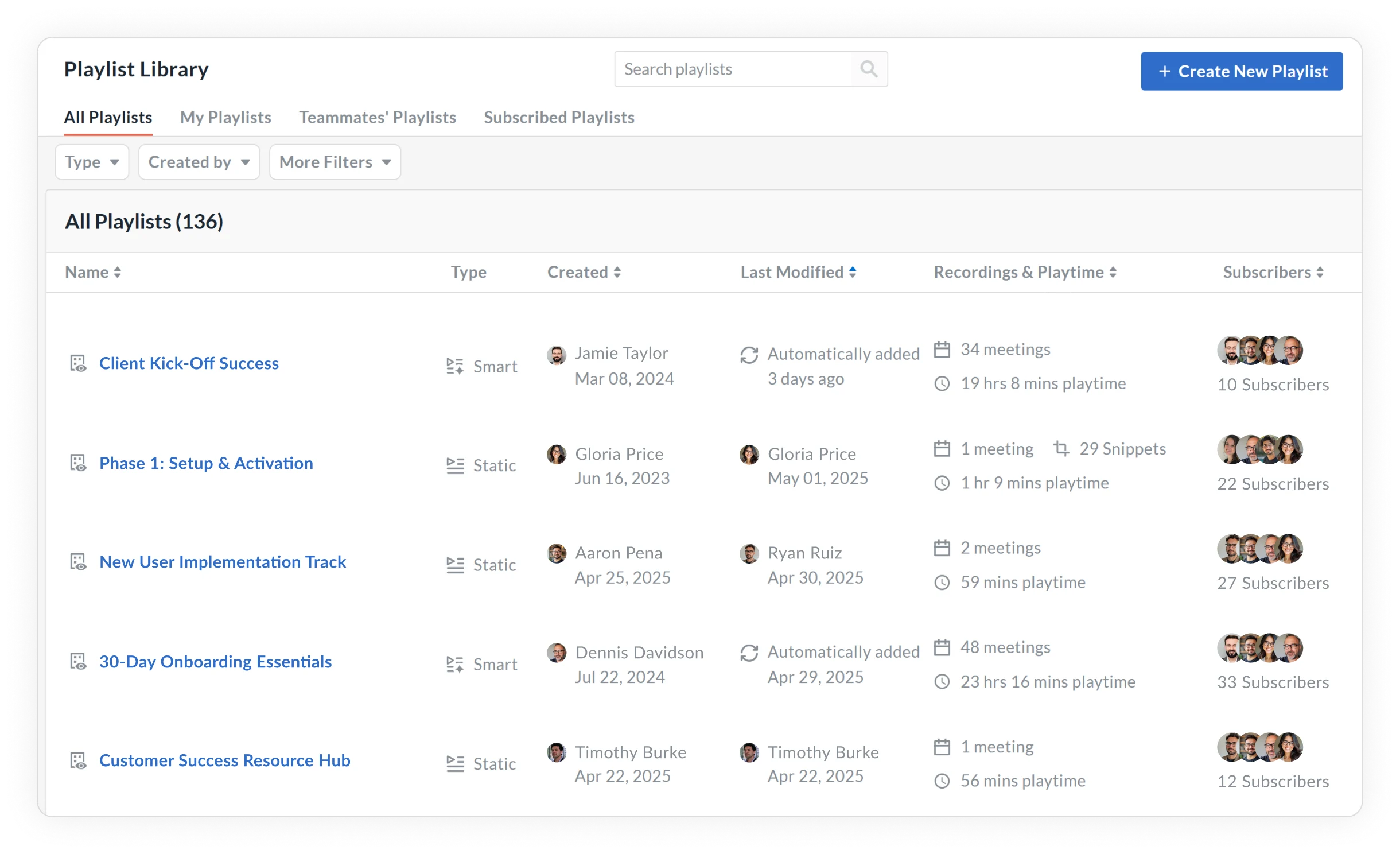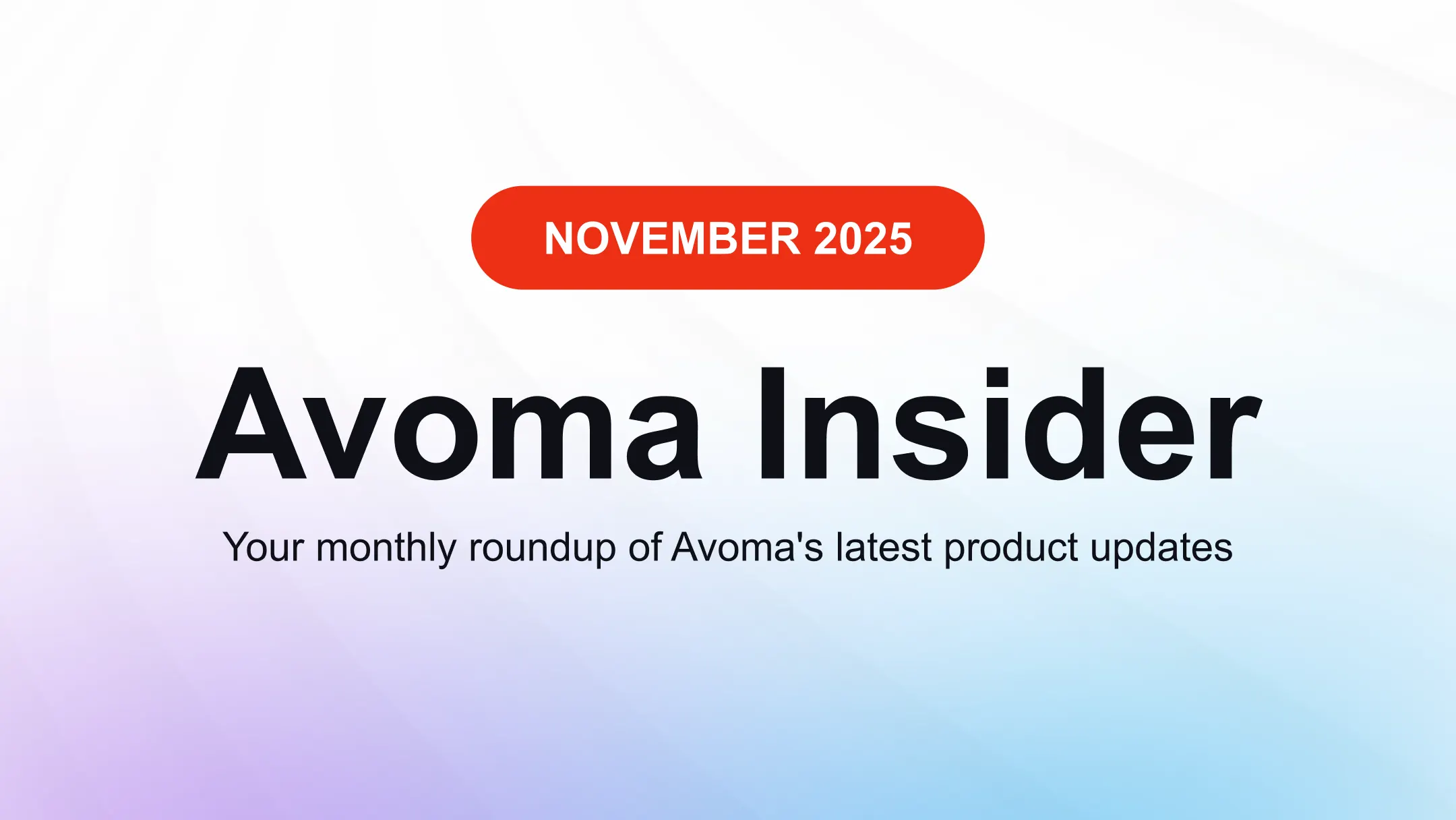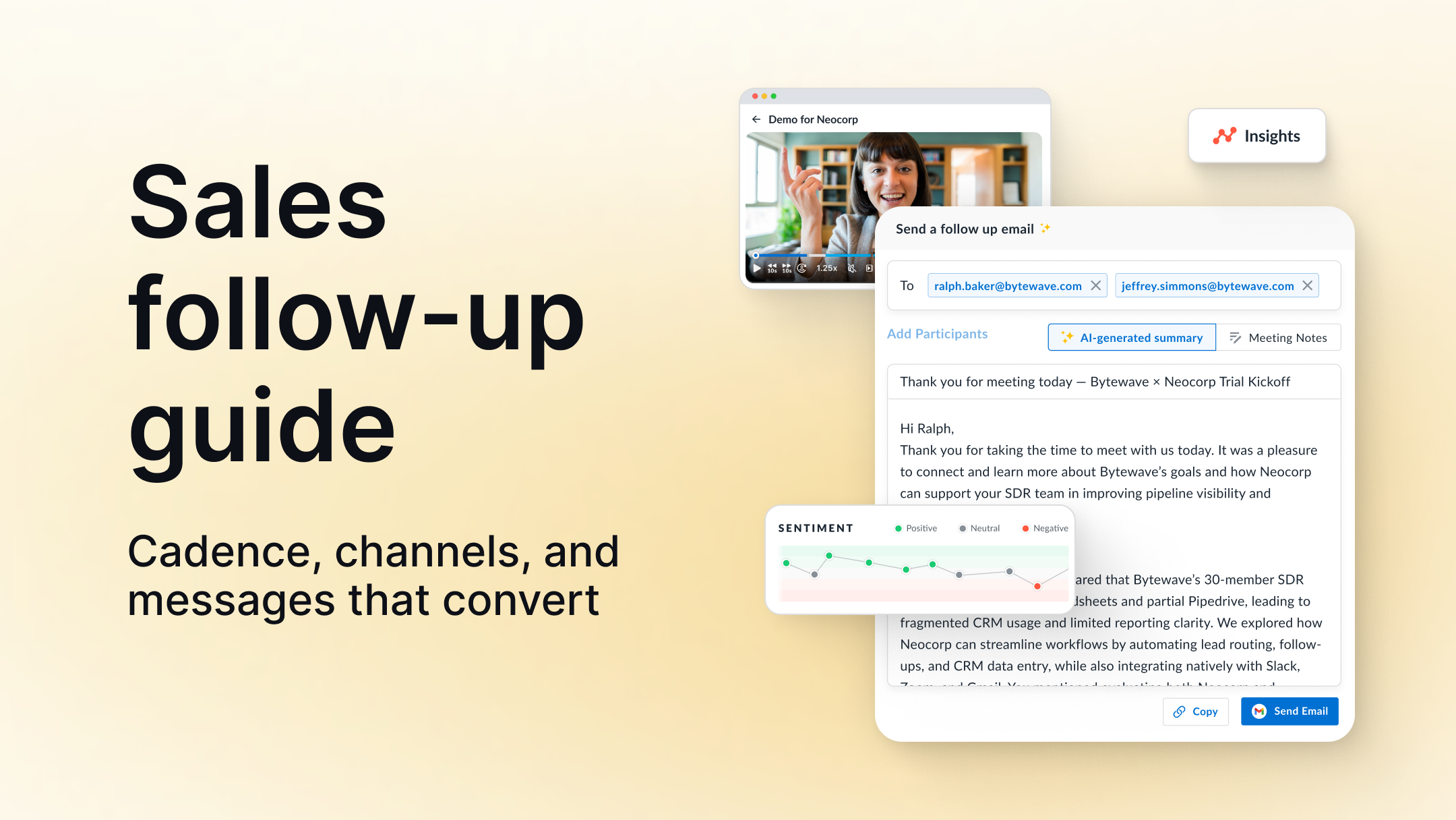What is Customer Success Enablement: The Complete Guide
Table of Contents:

Customer success enablement helps your CS team manage the account lifecycle from onboarding to renewal and expansion. It shapes how CSMs prepare for meetings, capture key points, and follow up on actions across accounts.
In this guide, you will learn what customer success enablement is, how it supports your revenue goals, and how to start building a program that fits your stage of growth.
What is Customer Success Enablement?
Customer success enablement is a business function that helps your CS team manage the customer lifecycle from onboarding to renewal and expansion. It equips CSMs with training, playbooks, and tools they use in their work with accounts.
Customer success teams work directly with accounts and own adoption, renewal, and growth targets. The enablement function builds and maintains the system they rely on to reach those goals. In some companies it is a dedicated role or small team inside CS. In others it sits inside a broader revenue or GTM enablement group.
What is the difference between Customer Success Enablement and Customer Enablement?
What is the difference between Customer Success Enablement and Sales Enablement?
Why Customer Success Enablement matters in 2025
Customer success enablement matters in 2025 because CS teams now share revenue ownership with sales, and growth depends as much on renewals and expansion as on new deals. When you standardize workflows, templates, and how CSMs capture outcomes from key meetings, leaders can compare how accounts move through onboarding, product reviews, and renewals. Without this, every CSM works in a different way, and leaders cannot see what is working, where accounts are stuck, or where the team needs support.
How to structure a customer success enablement framework
A customer success enablement framework outlines the main areas you design and standardize for your CS team. It helps you tie enablement decisions to clear outcomes like faster CSM ramp, better adoption, and stronger renewals. Most teams can start with these six building blocks.

- Goals and ownership
Who is responsible for CS enablement and which outcomes they support, such as CSM ramp time, product adoption, renewals, and expansion. - Workflows and playbooks
How CSMs should handle key moments like onboarding, product check-ins, QBRs, renewals, and expansion conversations. - Training and coaching
How you bring new CSMs up to speed and help the whole team improve, using real accounts and real calls. - Content and templates
Shared decks, email outlines, success plan formats, and note structures that CSMs can reuse instead of starting from scratch. - Tools and systems
The core tools that support this work, for example your CRM, CS platform, and meeting intelligence to record and review conversations. - Metrics and review cadence
The small set of numbers you track and when you review them, so you can see if the framework is working and where you need to adjust.
Customer Success Enablement by company stage
Early Stage
Typical setup
- No formal CS enablement role.
- Founder, VP CS, or Head of CS owns basic enablement work.
What customer success enablement looks like early stage
- Simple onboarding and QBR checklists.
- A small set of shared decks and email templates.
- One basic success plan template.
- Key customer calls recorded and shared with new CSMs.
Focus: Help new CSMs get up to speed and avoid everyone creating their own version of onboarding and renewals.
SMB / Mid-Market
Typical setup
- One clear owner for CS enablement.
- Either a CS leader with enablement as part of the role, or a first enablement hire.
What customer success enablement looks like for SMB/Mid-market
- Documented playbooks for onboarding, product reviews, QBRs, and renewals.
- A defined ramp plan for new CSMs.
- Shared library for decks, email copy, and success plans.
- Regular call reviews using meeting recordings.
Focus: Make CSM execution consistent and give leaders a clear view of account health and renewal risk.
Enterprise
Typical setup
- Customer success enablement as a defined function.
- Often part of a larger revenue or GTM enablement team, with CS specialists.
What customer success enablement looks like for enterprise
- Segment-specific playbooks and training for different customer tiers.
- Formal learning paths and levels for CSM roles.
- Central, maintained library of assets and call examples.
- Standard use of CS platforms and meeting intelligence across teams.
- Regular review of enablement impact using CRM, product usage, and call data.
- Tight alignment with Sales, Product, and Marketing on messaging and playbooks.
Focus: Keep many CS teams aligned on how they work with customers while supporting differences by segment and region.
Which activities should Customer Success Enablement prioritize?
When you start with customer success enablement, focus on the activities that repeat often and affect renewals and expansion.
Onboarding
- Checklist from contract signed to first value
- Standard kickoff agenda and deck
- Simple success plan template
- Playlists of onboarding calls

Ongoing check-ins and product reviews
- Guidance on cadence by segment
- Short list of core questions to ask
- Basic product-usage view to bring into the call
- Follow-up email and recap template
QBRs and renewals
- One QBR structure and core deck
- Talk tracks to show value and outcomes
- Clear approach for when and how to start renewal talks
- 2–3 good QBR / renewal call examples for coaching
Expansion and risk
- Expansion playbook with clear triggers
- Early-risk checklist with first steps
- Outreach templates for expansion and recovery
- Shared “expansion and risk” report for leaders and CSMs
What tools do you need for Customer Success Enablement?
Customer success enablement does not need a big stack. It needs a few tools that support how CSMs work every day.
1. CRMs
These hold your account and usage data.
- CRM for account, contact, and opportunity data
- Customer success platform to see health scores, segments, and lifecycle stage in one place
- Support tool for tickets and issues
Goal: CSMs see account details in one place before and after every meeting.
2. Meeting and conversation intelligence
This is a core layer for customer success enablement.
An AI-powered conversation intelligence software like Avoma:
- Records key customer calls and meetings
- Creates transcripts and summaries CSMs can scan
- Captures action items and next steps
- Makes calls searchable by topic, feature, or account
- Supports coaching with snippets, comments, and scorecards
- Pushes notes and key fields into the CRM
It helps with onboarding new CSMs, coaching with real examples, and running reviews based on actual customer conversations.
3. Knowledge, content, and training
This is not a tool, but a layer that keeps your team aligned on seamless engagement.
- Internal wiki or knowledge base
- Shared space for decks, email copy, and templates
- Simple training hub for onboarding and refreshers
Goal: CSMs can find the latest talk tracks and assets in one place.
What key metrics should you track for Customer Success Enablement?
Customer success enablement key metrics can be divided into three buckets.
1. Revenue outcomes
These tell you if stronger workflows and training help protect and grow revenue.
- Net revenue retention (NRR)
- Gross revenue retention (GRR)
- Renewal rate by segment
- Expansion revenue
2. Product and customer outcomes
These tell you if accounts actually get value from the product.
- Time to first value
- Adoption of key features
- CSAT or NPS by segment
3. Team and enablement outcomes
These tell you if the team is using what you build.
- CSM ramp time
- Share of key meetings recorded and reviewed
- Use of standard playbooks and templates
- Coaching coverage per CSM
How should Customer Success Enablement work with cross-functional teams?
Customer success enablement works best when it connects with Sales, Product, Marketing, and RevOps instead of sitting only in CS.
- Sales
Share late-stage call recordings so CSMs see context and commitments.
- Product
Share call snippets that show common requests, gaps, and strong wins.
Align on how CSMs talk about new features and changes.
- Marketing
Bring themes from QBRs and renewals into messaging and campaigns.
Help source customer stories and proof points from healthy accounts.
- RevOps
Align definitions, fields, and processes used in playbooks and reviews.
Build simple views that CS leaders and RevOps both use to track health and risk.
What are the most common customer success enablement mistakes to avoid?
Many customer success enablement efforts stall because of a few common mistakes.
No clear owner
Enablement sits between CS, Sales, and RevOps, so it often belongs to no one. To avoid this, assign ownership, even if it is part of a CS leader’s role.
Treating enablement as one-off training
Many teams run a big workshop, share a deck, and move on. CSMs go back to their old habits. Effective enablement shows up in playbooks, templates, and how CSMs run calls every week, not in single events.
Building assets that teams do not use
Playbooks, templates, and decks often stay in folders. They do not match how CSMs actually work or what customers ask. Involve CSMs in the design and base content on real calls and real accounts.
Leading with tools instead of workflows
Teams buy new software and then try to fit their process to the tool. This creates noise and extra steps. First define how you want onboarding, QBRs, renewals, and expansion to work. Then pick tools that support those flows.
Ignoring impact on revenue and adoption
Some teams measure enablement by the number of sessions or documents created. That says nothing about outcomes. Link your work to a few clear metrics, such as CSM ramp time, adoption of key features, renewal rate, and expansion in target segments.
How does Avoma support Customer Success Enablement?
An AI-powered platform like Avoma helps you turn customer meetings into usable input for your enablement framework and daily CS work.
It can help you:
- Onboard and ramp CSMs
New hires can listen to real onboarding, QBR, and renewal calls, so they see how experienced CSMs handle key conversations. - Standardize meetings and follow-ups
Shared notes, templates, and AI summaries keep how CSMs prepare, run, and close meetings closer to your playbooks. Notes, action items, and key fields can also sync back to your CRM. - Improve coaching with real examples
Managers can review recordings, leave comments on key moments, and use call snippets in team training, so feedback ties to real accounts.
If you are building or refining customer success enablement, check out Avoma. Get in touch with our product experts to supercharge your customer engagement.
Frequently Asked Questions
You are ready once you have multiple CSMs and start seeing inconsistent onboarding, uneven renewals, or slow ramp for new hires. At that point, improving enablement usually delivers more impact than adding another headcount, because it lifts the whole team’s performance.
No. Most teams get far with a CRM, a basic CS health view, a central knowledge hub, and one meeting intelligence platform. The goal is to streamline how CSMs work, not add more tools they need to maintain.
Avoma turns everyday customer meetings into assets for your enablement program. It records and summarizes calls, highlights risks and next steps, and pushes structured notes into your CRM. CS leaders can build onboarding, coaching, and QBR reviews around real conversations, not scattered notes, which makes your enablement efforts stick






What's stopping you from turning every conversation into actionable insights?









